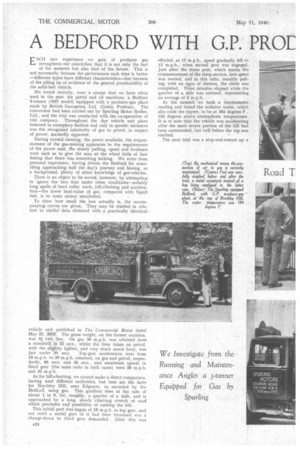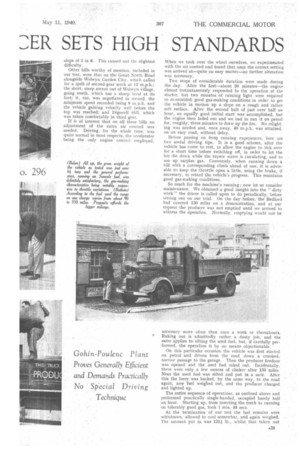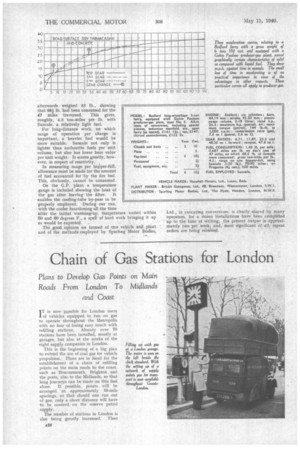A BEDFORD WITH G.P. PROF 7,ER SETS HIGH STANDARDS
Page 26

Page 27

Page 28

If you've noticed an error in this article please click here to report it so we can fix it.
ACII new experience we gain of producer gas strengthens our conviction that it is not only the fuel of the moment but also that of the future. This is not necessarily because the performance each time is better —different types have different characteristics—but because of the piling up of evidence of the general practicability of the solid-fuel vehicle.
We tested recently, over a course that we have often used in the past for petrol and oil machines, a Bedford 3-tonner (1937 model) equipped with a producer-gas plant made by British Gazogenes, Ltd. (Gohin Poulenc). The conversion had been carried out by Spurling Motor Bodies. Ltd., and the trial was conducted with the co-operation of this company. Throughout the day vehicle and plant behaved in exemplary fashion and only in specific instances was the recognized inferiority of gas to petrol, in respect of power, markedly apparent.
During normal running, the power available, the responsiveness of the gas-making apparatus to the requirements of the power unit, the steady pulling, speed and liveliness were such as to give the man at the wheel little of that feeling that there was something lacking. We write from personal experience, having driven the Bedford for something approaching half the day's journey and having, as a background, plenty of other knowledge of gas-vehicles.
There is no object to be served, however, by attempting to ignore the fact that under other conditions—notably long spells of hard collar work, hill-climbing and acceleration—the lower heat-value of gas, compared with liquid fuel, is to some extent manifested.
To show how small the loss actually is, the accompanying curves are given. They may be studied in relation to similardata obtained with a practically identical vehicle and published in The Commercial Motor dated May 21, 1937. The gross weight, on the former occasion, was 31 cwt. less. On gas 30 m.p.h. was attained from a standstill in 55 secs., whilst the time taken on petrol, with the slightly lighter, and very much newer lorry, was
just under 30 secs. Top-gear acceleration tests from 10 m.p.h. to 30 m.p.h. returned, on gas and petrol, respectively, 85 secs. and 35 secs., and maximum speeds in third gear (the same ratio in both cases) were 28 m.p.h. and 32 m.p.h.
Asior hill-climbing, we cannot make a direct comparison, having used different acclivities, but here are the facts for Brockley Hill, near Edgware, as ascended by the Bedford, using gas. This gradient rises at the rate of about 1 in 8, for, roughly, a quarter of a mile, and is approached by a long, slowly climbing stretch of road which precludes an possibility of rushing the hill.
This initial part was begun at 19 m.p.h. in top gear, and not until a useful part of it had been traversed was a change-down to third gear demanded. After this was effected, at 17 m.p h., speed gradually fell to 12 m.p.h., when second gear was engaged. Just after the stone post, which marks the commencement of the steep section, first speed was needed, and in this ratio, steadily pulling, with no signs of distress, the climb was completed. Three minutes elapsed while the quarter of a mile was covered, representing an average of 5 m,p.h.
At the summit we took a thermometer reading and found the radiator water, which also cools the tuyere, to be at 184 degrees F., 124 degrees above atmospheric temperature. It is of note that the vehicle was accelerating after the most severe portion of the hill bad been surmounted, but well before the top was reached.
The next trial was a stop-and-restart up a slope of 1 in 6. This caused not the slightest difficulty.
Other hills worthy of mention, included in our test, were that on the Great North Road alongside Wehvyn Garden City, which called for a spell of second-gear work at 12 m.p.h.; the short, steep ascent out of Welwyn village, going south, which has a sharp bend at its foot; it, too, was negotiated in second, the minimum speed recorded being 9 m.p.h. and the vehicle gaining velocity well before the top was reached; and Digswell Hill, which was taken comfortably in third gear. If is of interest that on all these hills no adjustment of the extra air control was needed. Driving, for the whole time, was quite normal in most respects, the accelerator being the only engine control employed. When we took over the wheel ourselves, we experimented with the air control and found that once the correct setting was arrived at—quite an easy matter—no further alteration was necessary.
Two stops of considerable duration were made during the day. After the first—about 20 minutes—the engine almost instantaneously responded fo the operation of the starter, but two minutes of running light were required to re-establish good gas-making conditions in order to get the vehicle in motion up a slope on a rough and rather soft surface. After the second halt of just over half an hour, an equally good initial start was accomplished, but the engine then faded out and we had to run it on petrol for, roughly, three minutes to draw up the fire. No relighting was needed and, once away, 40 m.p.h. was attained, on an easy road, without delay.
Before passing on frorp running experiences, here are two useful driving tips. It is a good scheme, after the vehicle has come to rest, to allow the engine to tick over for a short time before switching off, in order to let the fire die down while the tuyere water is circulating, and to use up surplus gas. Conversely, when running down a hill with a corresponding climb ahead of one, it is advisable to keep the throttle open a little, using the brake, if necessary, to retard the vehicle's progress. This maintains good gas-making conditions.
So much for the machine's running; now let us consider maintenance. We obtained a good insight into the "dirty work" the driver is called upon to do periodically, before setting out on our trial. On the day before: the Bedford had covered 130 miles on a demonstration, and at our request the producer was not emptied until we arrived to Witness the operation. Normally, emptying would not be necessary more often than once a week or thereabouts. • Raking out is admittedly rather a dusty job, and the same applies to sifting the used fuel, but, if carefully performed, the operation is by no means objectionable.
On this particular occasion the vehicle was first started on petrol and driven from the road down a crooked, narrow passage to the garage. Then the producer firedoor was opened and the used fuel raked out. Incidentally, there were only a few ounces of clinker after 130 miles. Next the used fuel was sifted and put in a sack. After this the lorry was backed, by the same way, to the road again, new fuel weighed out, and the producer charged and lighted up.
The entire sequence of operations, as outlined above and performed practically single-handed, occupied barely half an hour. Starting up, from inserting the torch to running on tolerably good gas, took I min. 55 secs.
At the termination of our test the fuel remains were withdrawn, allowed to cool somewhat, and again weighed. The amount put in was 121i lb., whilst that taken out afterwards weighed 53 lb., showing that 68i lb. had been consumed for the 47 miles traversed. This gives, roughly, 4.5 ton-miles per lb. with Suncole, a relatively light fuel.
For long-distance work, on which range of operation per charge is important, a heavier fuel would be more suitable. Suncole not only is lighter than anthracite fuels per unit volume, but also has lower heat value per unit weight. It scores greatly, however, in respect of reactivity.
In measuring range per hopper-full, allowance must be made for the amount of fuel accounted for by the fire bed. This, obviously, cannot be consumed.
On the G.P. plant a temperature gauge is included showing the heat of the gas after leaving the filter. It enables the cooling-tube by-pass to be properly employed. During our run, with the cooler functioning all the time after the initial warming-up, temperature varied within 50 and 60 degrees F., a spell of hard work bringing it up as would be expected.
The good opinion we formed of this vehicle and plant and of the methods employed by Spurling Motor Bodies,




























































